Finding truly innovative church stage design ideas can be a challenge.
You want to create a beautiful and functional design – and break free from the methods we’ve been using for over a decade. But building architecture and budget can limit your options.
So how do you create the best church stage designs that will bring the WOW factor?
In this article, we’ll offer inspiration for various design ideas for churches of all sizes.
Read on to find out how you can get creative and style a space that is beautiful but keeps the focus on God and worship.
Estimated reading time: 16 minutes
Table of content
Worship music stage design
Overhead stages and ambient lighting
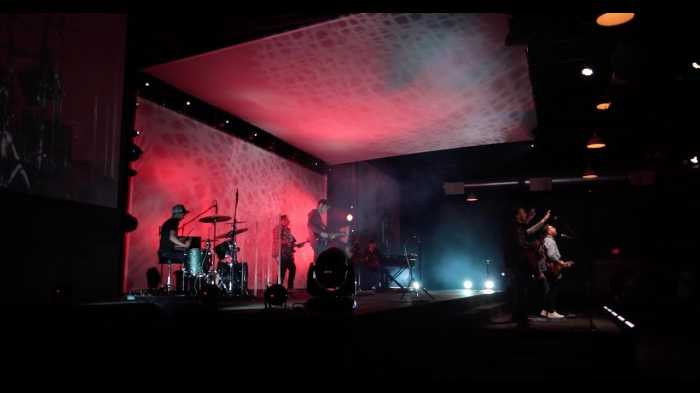
Churches are experimenting with new stage designs and trying to escape from the traditional sandwich backdrop.
Mosaic OKC, has an example of a stage with a unique layout. They’ve also used more ambient lighting, something we see more of below.
This can create a really dramatic and innovative looking space.

Maybe you’ve seen some modern church stage designs with this look in recent worship music videos.
Rather than utilizing a traditional stage background, ambient lighting floods the space from above.
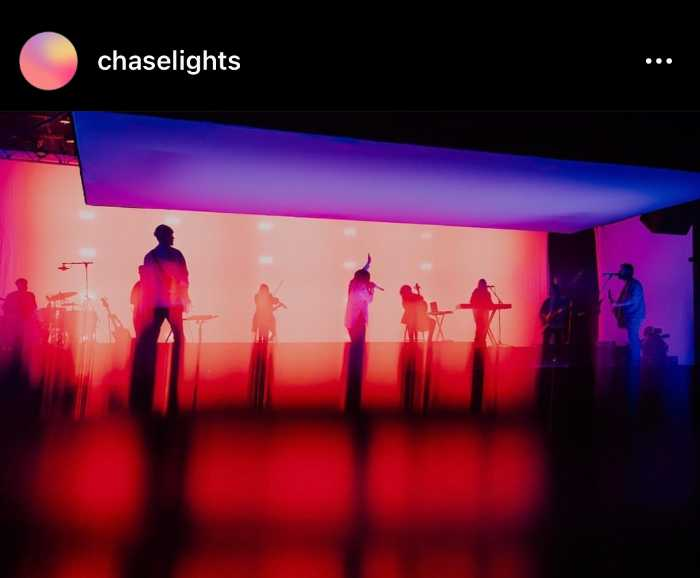
The pictures above are from a recent Kari Jobe live album (video recording available on YouTube).
And this room design below is from the Elevation Worship live album recording.
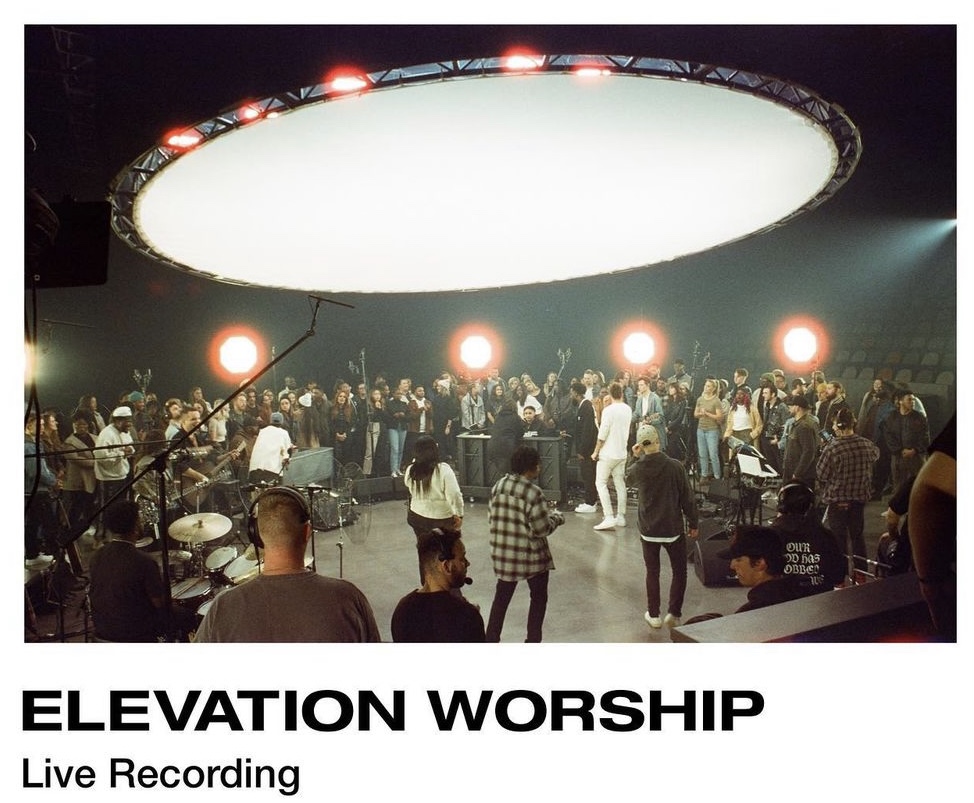
Cheap Design Ideas for Smaller Church Stages
Before we move on to more costly ideas, let’s look at some more budget-friendly church stage options.
If you have a building that was built a few decades ago, or a smaller auditorium, you don’t necessarily need a big and flashy stage design.
In fact, sleek and simple, even minimal, can be better for a smaller platform.
You don’t want to add too many elements or busy backgrounds. This will only make your room feel cluttered.
Also, your church stage designs should never take the focal point away from worship and the teachers and speakers.
The stage design ideas below are great for smaller churches or auditoriums.
Deco shapes with hanging lights
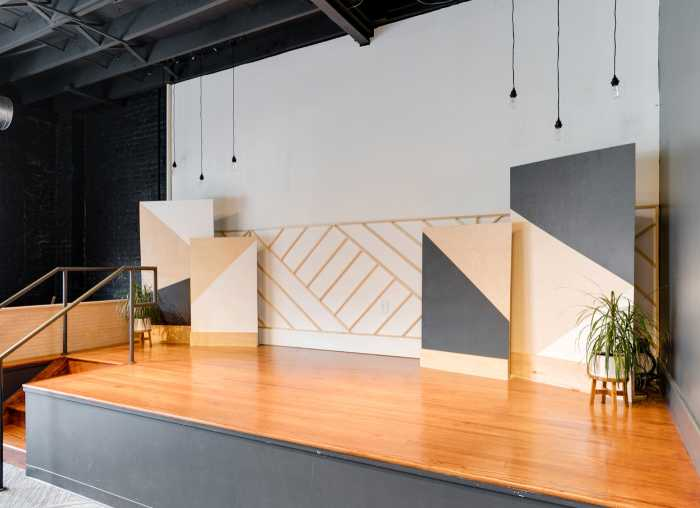
This modern church stage background idea is simple and extremely versatile. You could use a variety of inexpensive materials, such as plywood and chloroplast.
Also, you can easily alter the shapes, colors, and designs to match your church branding or current sermon series theme.
Finally, add some hanging cafe lights or Edison bulbs for dimension and depth.
Mini bulb (ping pong balls) design
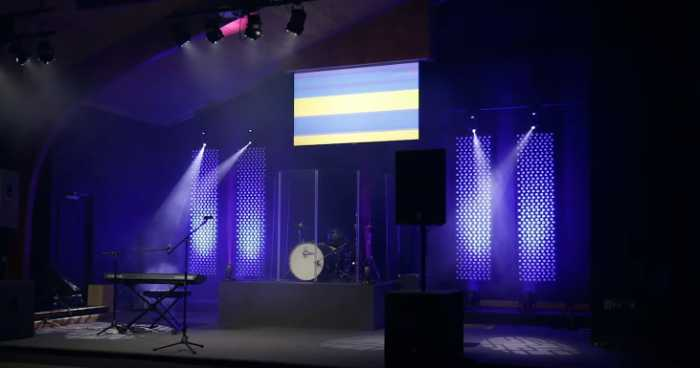
Here is an example from a youth auditorium. This genius stage design idea starts with a pegboard painted black.
Then, ping pong balls are hot glued onto the board in a staggered pattern.
Finally, the boards are hung on a metal rod and lit up with LED lights. You can use any color combination you like!
Find more details on materials and assembly here.
Wood Design Ideas

You can do a lot with wood to create an attractive worship space. And depending on the type of lumber you use, these designs can be inexpensive and versatile.
This material provides a neutral and natural look, which works well at Easter, Christmas, and other times of year.
Whether you use boards or pallets, you can make a great backdrop or feature piece.
You can also paint the wood or cover it with foam or fabric to add more color and dimension.
Styrofoam Bright Lights
If you’re in a traditional building but want a more modern look, lighting can make a huge difference!
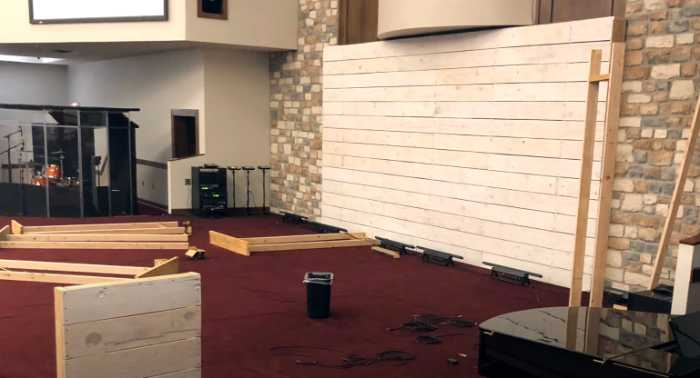
This design starts with a black backdrop.
Then, the team utilized volunteers to assemble styrofoam balls cut in half and assembled onto black panels.
As you can see, if you’re willing to DIY, you can save money and fully transform the look of your platform.
More about assembly.
Christmas stage design ideas
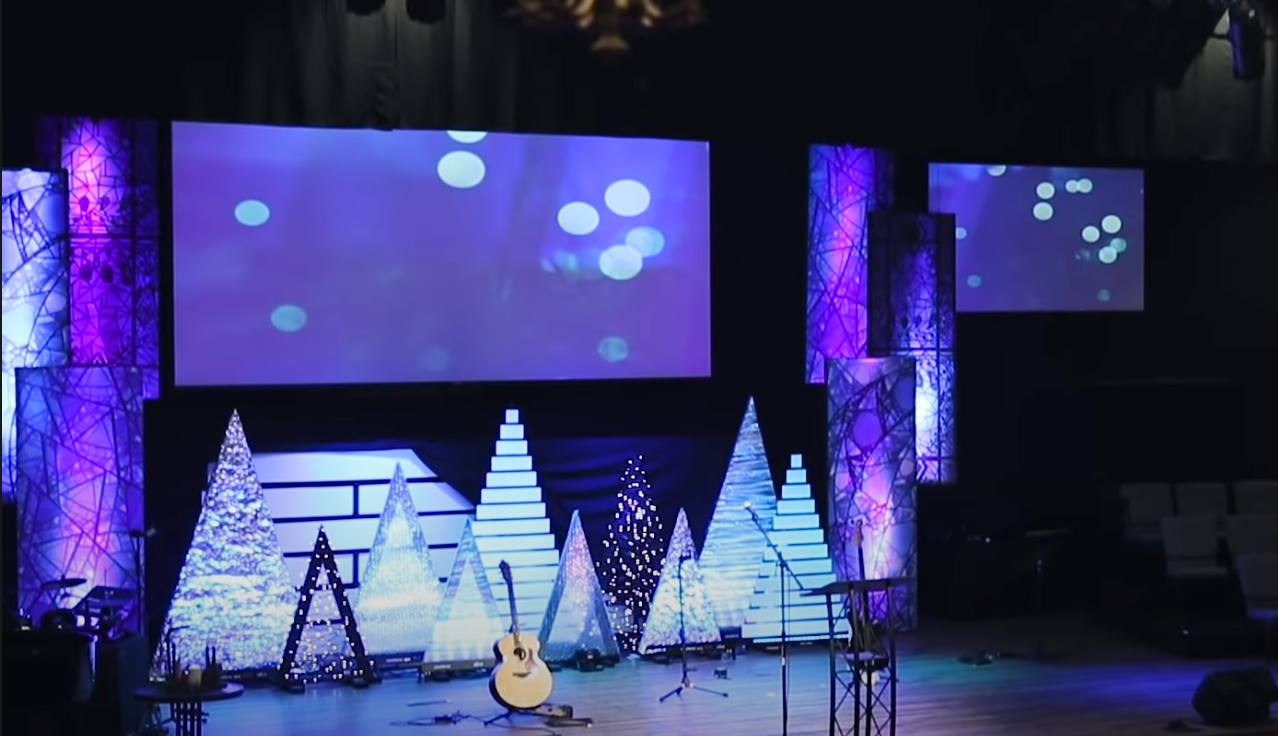
These trees are cut and assembled from wood and chloroplast (a long-time favorite).
The shiny trees are wrapped in saran wrap, bubble wrap, and Christmas string lights. Behind the trees, you can also see a background made of horizontal pieces of chloroplast.
Find more details about lighting and materials here.
Also don’t forget about Easter service ideas! Using the theme of the cross and resurrection never gets old.
LED Lights and Walls for Church Stages
Having great lighting is everything when it comes to stage designs with a wow factor. And LED lights and screens are a popular choice for stages.
These screens, panels, strips, and tapes can transform the room and work for any style.
LED Wall
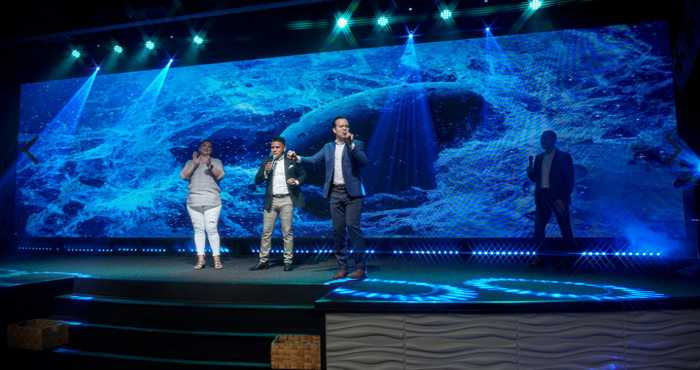
LED walls are a popular choice for churches. And if you have one giant wall on the back of your stage, it makes a huge impact.
You can use LED screens and panels to provide an attractive backdrop for your stage and can also use them to display lyrics, scripture verses, and other essential information.
Plus, LED walls are perfect for backgrounds and creating a visual effect that will capture your congregation’s attention.
If you’re interested in an LED wall or screens, be sure to consult with a professional. They can help you choose the right size and color for your needs, as well as recommend specific types of content that would be most effective on an LED wall.

You can get as creative as you like when it comes to sizes, shapes, and arrangements of LED panels.
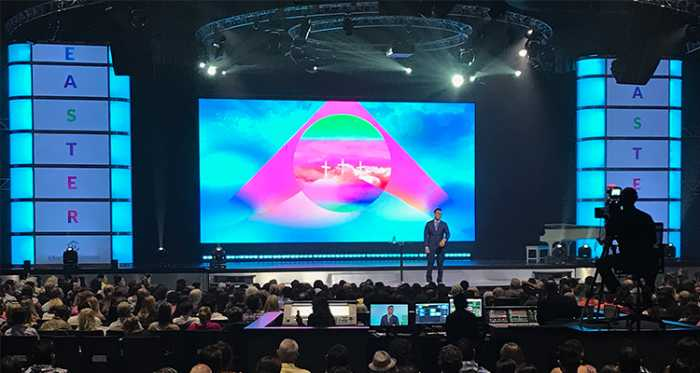
LED Tape

LED tape is a great way to add an extra flair to your church stage designs.
You can use it to create a backlight for your stage curtains or to light up the front of the stage.
Or you can also use it to create designs and patterns on the stage floor or your back drop.
Strips, bars, and tape lighting are also a great way to add color. You can incorporate different palettes to match your service’s theme or create a visually appealing effect.
Here’s another example and how-to.
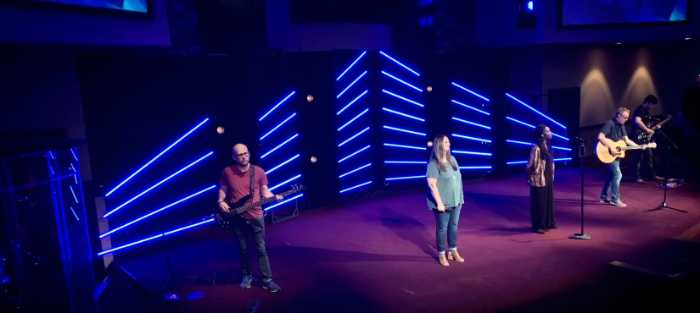
How to Successfully Create Your Own Church Stage Designs
If you can afford to have a professional lighting and stage design company come in to provide you with equipment and setup, that’s ideal.
But many churches don’t have the budget, so that means it’s time to get creative with DIY designs.
Many of the designs in this post were created by volunteer teams from the ground up. If you go that route, here are tips to keep in mind.
Tips for creating your own church stage designs
Start with a blank slate.
That way, you can be as creative as you want and not feel limited by preexisting designs.
Do your research.
Look online or at local churches for inspiration, tools, and examples to spark your creativity. This will provide you with some direction, then let your creativity take wings!
Set up a project timeline.
Creative projects often take longer than you think. Make sure you’re realistic about the time and effort your vision requires. Each element needs to be created, then you need to assemble and test lighting and video.
Keep it simple.
When it comes to church stage design, less is often more. Be true to your style, pick one main focal point, and think about what best serves the congregation.
Get help!
Don’t try to do it alone. The most important thing is to build a team of staff and volunteers. You probably have creative folks and those with power tools and expertise in construction in your midst – just ask!
Before and After Stage Design
It can be tempting to compare yourself with other churches, whether its services, attendance, or buildings.
But remember, everyone has a different culture, style, and budget. God has called you to serve your congregation.
The best church stage designs make the most of your space, lighting, and focus on worship.
Instead of comparing yourself with the most popular church on social media, give yourself and your team credit for the improvements you’ve made. This is the most important thing.
Just consider the epic difference in these before and after photos!


Logistics of Church Stage Design
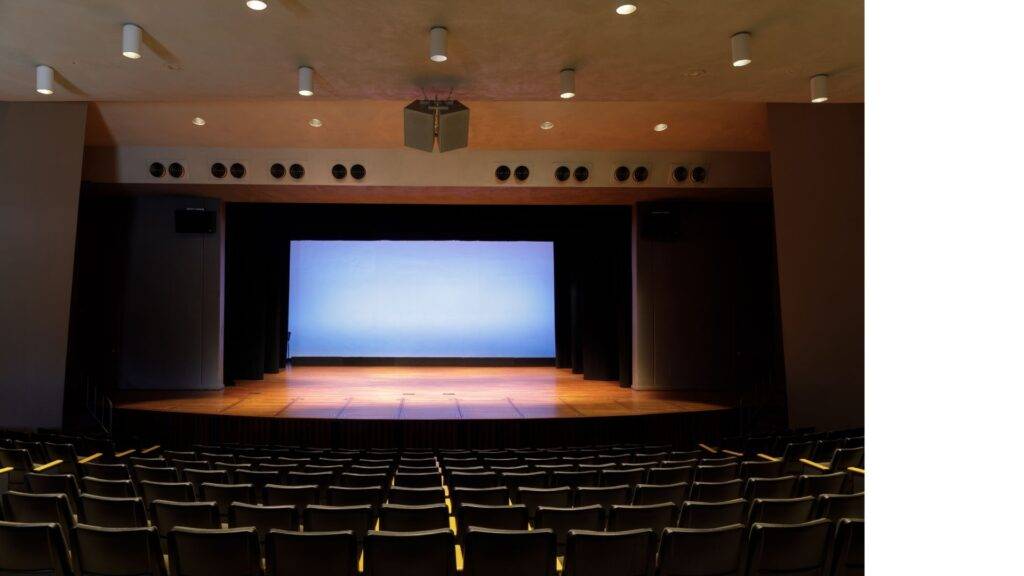
Ah, contemporary church stage design – a dynamic blend of tradition and innovation. While it holds incredible potential for elevating the worship experience, it’s not without its fair share of challenges and opportunities. Let’s dive into this exciting realm and explore what it takes to navigate the twists and turns of modern church stage design.
Financial Restraints
First off, let’s address the elephant in the room: budget constraints. Limited financial resources can often put a damper on ambitious design plans. We know that raising money is hard. According to the Wall Street Journal, there has been a decline in church construction due to decreasing funds going into church.

But fear not! Creative problem-solving and strategic planning can help overcome these hurdles.
Seeking cost-effective alternatives, exploring DIY options, or even rallying the community for support can stretch the budget further and make the seemingly impossible, possible.
Traditional vs. Modern
Now, let’s talk about the delicate balance between preserving tradition and embracing modern interpretations. Incorporating contemporary elements while staying true to the sacred symbols and practices can be a tightrope walk.
However, it presents a unique opportunity to bridge the gap between generations and cater to the diverse needs of the congregation. Finding that sweet spot where old meets new can create a harmonious and inclusive environment that resonates with everyone.
Technology
Adapting to the ever-evolving technological landscape is another challenge that can’t be ignored. With advancements happening at lightning speed, keeping up with the latest tech trends can be a daunting task. However, it also opens doors to endless possibilities.
Integrating state-of-the-art audiovisual equipment, interactive displays, or immersive experiences can create a vibrant and engaging worship atmosphere that speaks to the tech-savvy generation.
Community Involvement
One must not overlook the importance of community involvement and feedback. Understanding the pulse of the congregation and incorporating their diverse perspectives can foster a sense of ownership and belonging. Creating a space that reflects the collective values and aspirations of the community can strengthen the emotional connection to the church and enhance the overall spiritual experience.
Opportunities
In the midst of these challenges, lies a sea of opportunities waiting to be explored. Embracing creativity, resourcefulness, and adaptability can transform obstacles into stepping stones for growth and innovation.
Whether it’s exploring unconventional design concepts, experimenting with sustainable materials, or fostering a culture of inclusivity, each challenge presents a chance to leave a lasting impact on the community and the worship experience.
By embracing these challenges as catalysts for positive change and viewing opportunities as gateways to creativity, we can create a path toward a more enriching and meaningful worship experience for all.
Frequently Asked Questions

1. Why is stage design important in a church?
Stage design is important in a church because it sets the tone for the entire worship experience. It’s like the canvas for a masterpiece, creating an atmosphere that not only captures attention but also facilitates a deeper spiritual connection.
The careful arrangement of elements on the stage, from lighting and decor to multimedia integration, helps to amplify the impact of the message being conveyed. It’s more than just aesthetics; it’s about creating an environment that encourages engagement.
When it comes down to it, your church’s stage design can be fairly far down your list. There are more important things in a church than the design of the center stage. However, for churches that can afford the time and resources for it, designing a beautiful stage can help support all the other aspects of the room and the services.
2. What is a reasonable budget for designing a church stage?
Determining a reasonable budget for a church stage can be a bit of a balancing act. It depends on various factors like the size of the church, the complexity of the design, and the specific needs and goals of the congregation.
While there isn’t a one-size-fits-all answer, we suggest you consider a budget that allows for both quality and practicality. Flexibility is key here, as it’s important to account for potential unexpected costs that might arise during the design and implementation process. We suggest shooting for something a bit below your budget to account for anything that may appear.
Collaborating with experienced professionals (especially those you know and trust) and seeking cost-effective alternatives can help stretch the budget without compromising on the overall vision and quality of the stage.
3. What role does community feedback play in the design process?
Community feedback plays an important role in the design process, serving as a compass that guides the creation of a space that truly serves the church’s members. However, this feedback should be taken with discernment and understanding that most people have no expertise or knowledge in this area. You should listen to your church community but also get advice from professionals.
In general, church members are great at pointing out flaws or problems, but not very good at coming up with solutions to those problems. Seek out the opinions of your church community, especially those regarding issues with your current setup, but be wary of any suggestions they may have on how to solve those problems.
4. What considerations should be made for the acoustics of the stage area?
When thinking about the acoustics of the stage area, it’s important to take into account both the formal and informal aspects to ensure optimal sound quality. Pay attention to the materials used for the stage construction – materials like wood or fabric can help in diffusing sound waves, reducing echoes, and creating a warmer acoustic environment, which is crucial for a more intimate worship experience.
Moreover, considering the placement and type of microphones and speakers is key. Opt for high-quality microphones that can capture clear and crisp audio, and strategically position speakers to evenly distribute sound throughout the space. This will prevent any unpleasant distortions or uneven sound distribution that might distract the congregation during services.
Don’t forget to factor in the room’s overall design and layout as well. Make sure to use sound-absorbing materials like carpets or acoustic panels to minimize reverberations and echoes, ensuring that the sound remains clear and intelligible. Additionally, keep an eye on the overall room shape and size, as these factors can significantly impact how sound travels within the space.
More Resources for Church Stage Design Ideas
It can be challenging to come up with church stage design ideas on your own. Luckily, there are lots of resources available to help you. Here are a few of our favorites:
Worship Leader Hangout is a YouTube channel featuring worship, sound, and production tips. It also has amazing ideas, how-to tutorials, and church tours to help freshen up your church stage design.
Follow @chaselights on Instagram. If you’re looking for some inspiration in church stage design and lighting, you need to check out Chase Hall. He’s a trendsetter and top-of-the-game when it comes to fresh church stage design ideas. His work is absolutely amazing.
For step-by-step ideas, equipment, and processes for church stage designs, check out this website. These church stage designs come directly from local church leaders around the country.
Bottom Line
When it comes to design and media, the goal is authentic worship. Nobody is trying to replace the church mission with a spectacular media show. The worship, the sermon series, the words of encouragement, all of the things said on the stage are more important than the stage itself.
The platform is just one element of a worship experience that changes peoples’ lives.
We come together in services to worship, hear a message from the Lord, and grow together.
Do you have a great church stage design that would be helpful for other churches to see? Let us know in the comments below and we can feature it here!





Comments 3
Hi there,
I’m a worship pastor in a traditional church setting, stained glass windows that line the both sides of the sanctuary, but contemporary music worship and style all around. Currently, our front looks similar to what these “before” shots look like on your page. Any suggestions for going LED with still so much light in the main house? Thank you.
Author
Hey Kerry, Transitioning to LED lighting can really enhance your contemporary worship vibe while keeping that traditional charm intact. For your stained glass sanctuary, I’d suggest dimmable LED fixtures with warm tones. They’ll add that modern touch without overwhelming the space with light.